The
modern approach to word studies is based on distinguishing between
the external
and
the
internal structures
of the word.
By
external
structure of the word we
mean its morphological
structure.
For example, in the word post-impressionists
the
following morphemes can be distinguished: the prefixes post-,
im-, the
root press,
the
noun-forming suffixes —ion,
—ist,
and the grammatical suffix of plurality -s.
All these morphemes constitute the external structure of the word
post-impressionists.
The
internal
structure of the word, or
its meaning,
is
commonly referred to as the word’s semantic
structure. This
is the word’s main aspect. Words can serve the purposes of human
communication solely due to their meanings.
The
area of lexicology specializing in the semantic studies of the word
is called semantics.
Another
structural aspect of the word is its unity.
The word possesses both external (or formal) unity and semantic
unity. Formal unity of the word is sometimes interpreted as
indivisibility. The example of post-impressionists
has
already shown that the word is not indivisible. Yet, its component
morphemes are permanently linked together in opposition to
word-groups, both free and with fixed contexts, whose components
possess a certain structural freedom, e.g. bright
light, to take for granted.
The
formal unity of the word can best be illustrated by comparing a word
and a word-group comprising identical constituents. The difference
between a
blackbird and
a black bird is
explained by their relationship with the grammatical system of the
language. The word blackbird,
which
is characterized by unity, possesses a single grammatical framing:
blackbird/s.
The
first constituent black
is
not subject to any grammatical changes. In the word-group a black
bird each
constituent can acquire grammatical forms of its own: the
blackest birds I’ve ever seen. Other
words can be inserted between the components: a
black night bird.
The
same example may be used to illustrate what we mean by semantic
unity.
In
the word-group a black
bird each
of the meaningful words conveys a separate concept: bird
– a
kind of living creature; black
– a
colour.
The
word blackbird
conveys
only one concept: the type of bird. This is one of the main features
of any word: it always conveys one concept, no matter how many
component morphemes it may have in its external structure.
A
further structural feature of the word is its susceptibility
to
grammatical employment. In speech most words can be used in different
grammatical forms in which their interrelations are realized.
All
that we have said about the word can be summed up as follows.
The
word
is
a speech unit used for the purposes of human communication,
materially representing a group of sounds, possessing a meaning,
susceptible to grammatical employment and characterized by formal and
semantic unity.
-
The main problems of lexicology
Two
of these have been already underlined. The
problem of word-building is
associated with prevailing morphological word-structures and with
processes of making new words. Semantics
is
the study of meaning. Modern approaches to this problem are
characterized by two different levels of study: syntagmatic
and
paradigmatic.
On
the syntagmatic
level, the
semantic structure of the word is analysed in its linear
relationships with neighbouring words in connected speech. In other
words, the semantic characteristics of the word are observed,
described and studied on the basis of its typical contexts.
On
the paradigmatic
level, the
word is studied in its relationships with other words in the
vocabulary system. So, a word may be studied in comparison with other
words of similar meaning. E.g. work
n – labour
n.
Work работа,
труд; 1
the
job that a person does especially in order to earn money. This word
has many meanings (in
Oxford Dictionary – 14),
many synonyms and idioms [`idiemz]: creative
work творческая
деятельность; public
work общественные
работы;
his life`s work дело
его жизни; dirty
work (difficult,
unpleasant) 1
чёрная работа; 2
грязное
дело, подлость.
Nice
work! Отлично!
Здорово!
Saying (поговорка):
All
work and no play makes Jack a dull boy (мешай
дело с бездельем, проживёшь век с
весельем)
–
it is not healthy to spend all your time working; you need to relax
too.
Labour:
“work”
и “labour” не взаимозаменимы; labour
– 1 work,
especially physical work: manual
labour,
a
labour camp
– исправительно-трудовой
лагерь; 2
people
who work: a
shortage of labour; cheap labour; skilled labour –
квалифицированные
рабочие, Labour
Party; labour relations; a labour of
Sisyphus;
Sisyphean
labour [,sisi‘fi:en]
сизифов труд; тяжёлый и бесплодный труд
– of a task impossible to complete. From the Greek myth in which
Sisyphus was punished for the bad things he had done in his life with
the never-ending task of rolling a large stone to the top of a hill,
from which it always rolled down again.
Other
words of similar meaning (e.g. to
refuse v – to reject v),
of
opposite meaning (e.g. busy
adj – idle adj; to accept v – to reject v),
of
different stylistic characteristics (e.g. man
n – chap n – bloke n – guy n).
Man
–
chap
(coll.)
–
парень, малый; a
good chap
–
славный малый; old
chap – старина;
chap
– BrE,
informal,
becoming old-fashioned – used to talk about a man in a friendly
way: He
isn`t such a bad chap really. Bloke
(coll.)
тип,
парень: He
seemed like a nice bloke.
Guy
– coll.
US – малый;
tough
guy железный
малый; wise
guy умник;
guys
(informal,
especially US) a
group of people of either sex: Come
on, you guys!
Consequently,
the main problems of paradigmatic studies are synonymy,
antonymy, functional styles.
Соседние файлы в предмете [НЕСОРТИРОВАННОЕ]
- #
- #
- #
- #
- #
- #
- #
- #
- #
- #
- #
Слайды и текст этой презентации
Слайд 1The Word
The Word as a Fundamental Unit of Language
Morphemic Structure
of Words
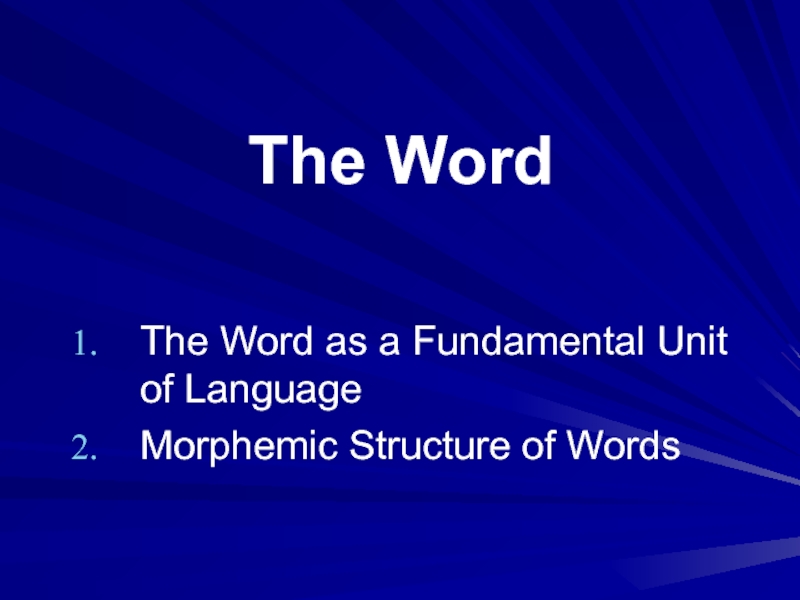
Слайд 2The main features of the word
possesses an external and
internal structure
is susceptible to a certain grammatical employment
has lexical-grammatical
valency
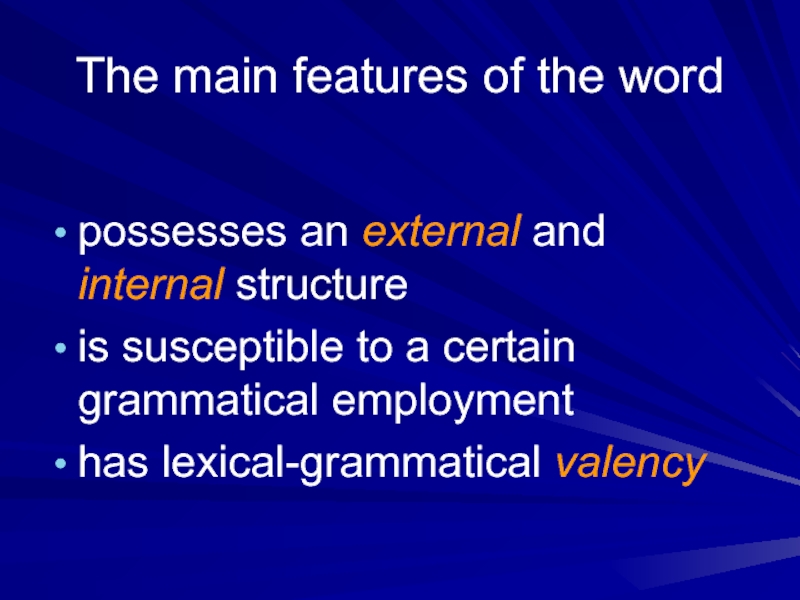
Слайд 3The structure of the word
external structure of the word:
sound structure
graphical
structure
morphological structure
internal structure of the word:
meaning
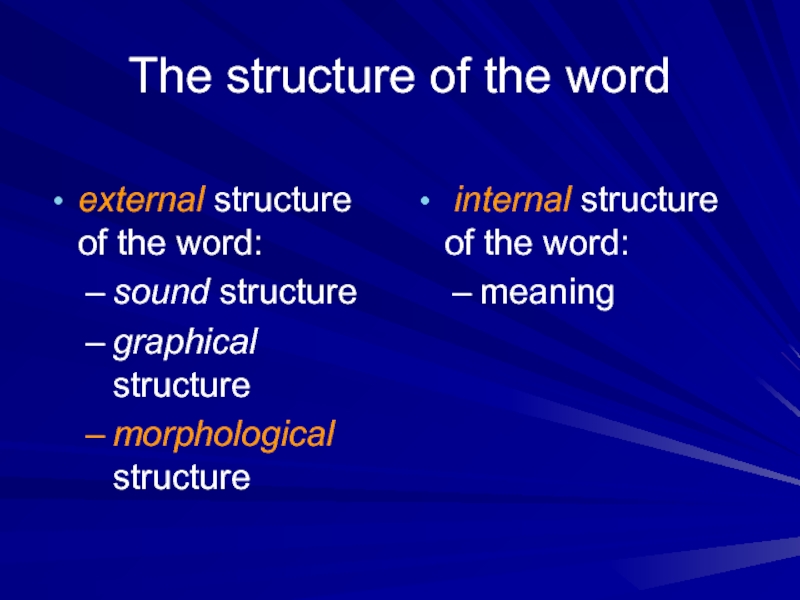
Слайд 4Susceptibility to grammatical employment
employment of words in speech in
different grammatical forms constituting their grammatical paradigm
Worker Easy To
Swim
— worker — easy — to swim
— workers — easier — swam
— worker’s — the easiest — swum
— workers’ — swimming
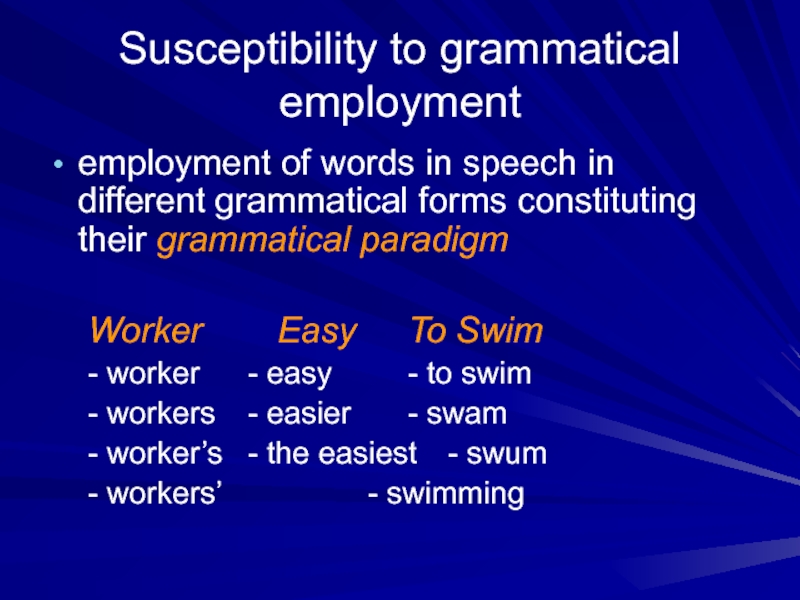
Слайд 5The Word
the minimal independent unit of utterance (L. Bloomfield)
a linguistic
unit taken to denote the smallest independent, indivisible unit of
speech (H. Marchand)
the basic unit of the language system in which a given group of sounds is associated with a given meaning, and which is susceptible to a given grammatical employment
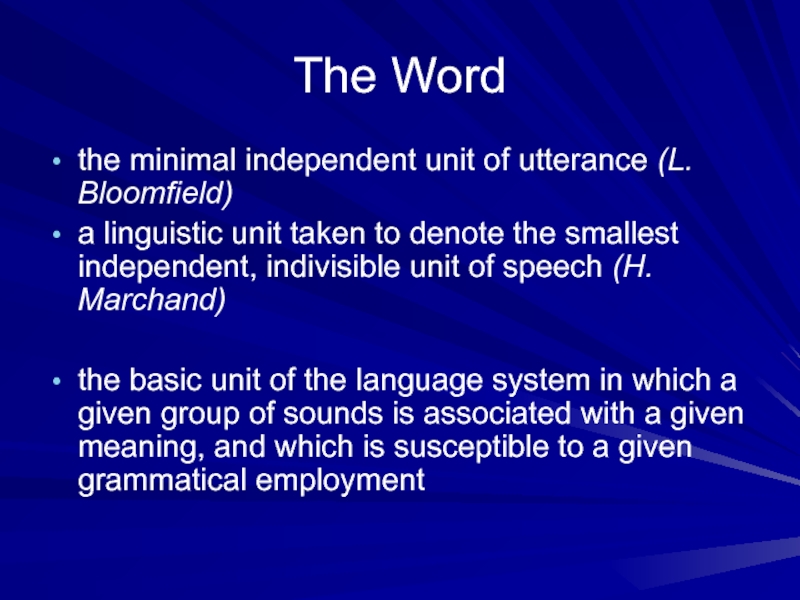
Слайд 6Syntagmatic and paradigmatic relations between the words
Syntagmatic relations
Left-hand combine-ability
a cold day
Right-hand combine-ability
a cold day

Слайд 7Context
the minimum stretch of speech sufficient to determine which
of the possible meanings of a given word is used
in it
Yellow
Her curly yellow hair looks wonderful.
the color between green and orange in the spectrum
He’d better get back there quick and prove he’s not
yellow.
informal cowardly
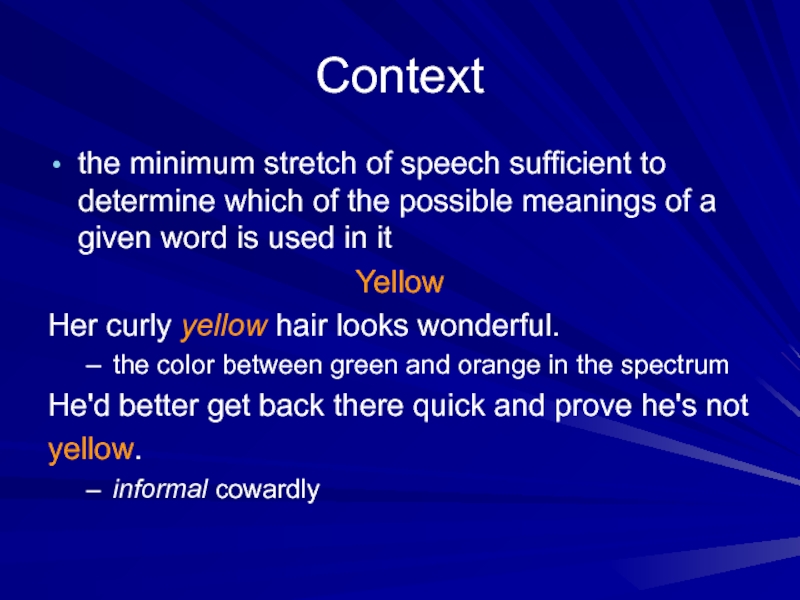
Слайд 8Paradigmatic relations
grammatical level
reveal themselves
through grammatical
paradigms
semantic level
reveal themselves
through
the meaning
of words
form the base for
synonymy and
antonymy
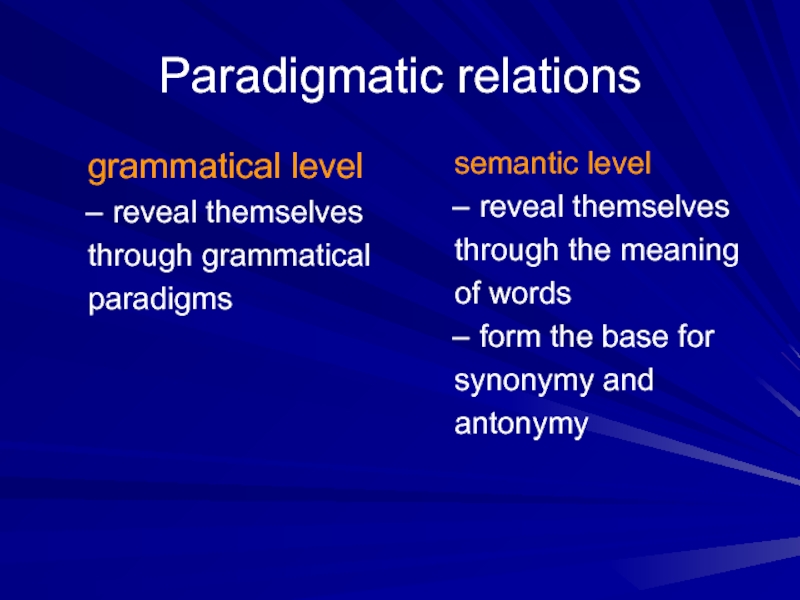
Слайд 9Morphemic structure of words
Morpheme − «morphe» means «form» and the
suffix «-eme» denotes the smallest unit or the minimal distinctive
feature
the minimal meaningful form of language, capable of retaining the same meaning in a variety of linguistic contexts
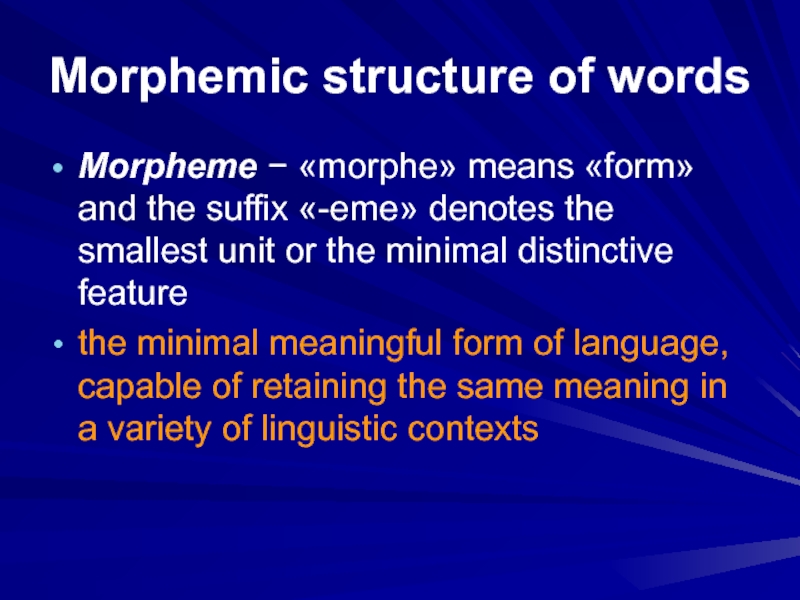
Слайд 10According to their structure all the words can be divided
into:
monomorphemic words – consist of only one morpheme: cat, get,
sit, go;
bimorphemic words − consist of two morphemes: love-ly, re-write, question-able
polymorphemic words − consist of three or more morphemes: dis-obedient-ly,
ir-respons-ible, un-eat-able
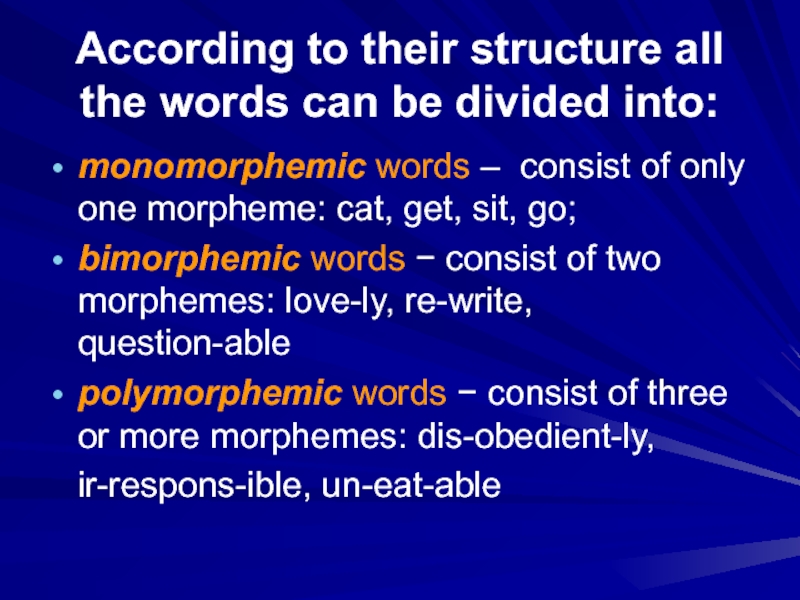
Слайд 11Classification of morphemes
according to the role they play in constructing
words
according to their position in words
according to the
degree of freedom
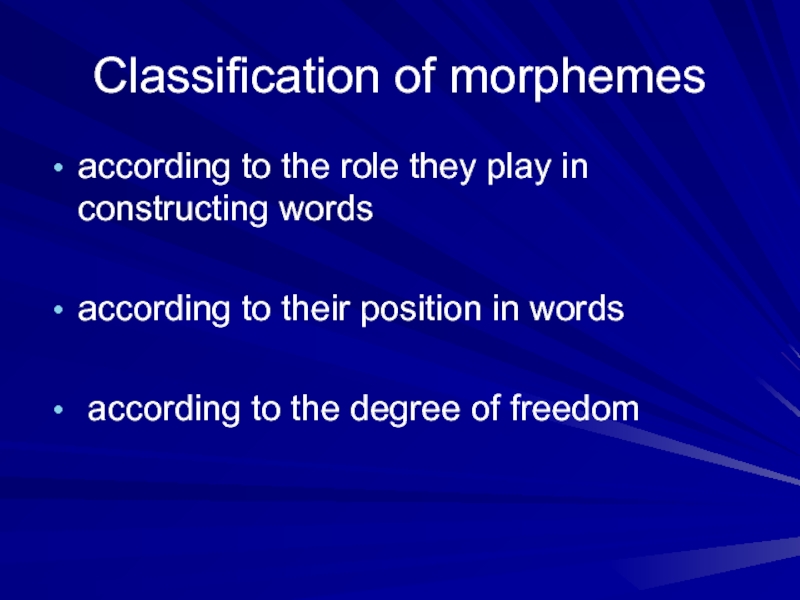
Слайд 12According to the role they play in constructing words
a
root-morpheme
the primary component of a word, its basic part
which conveys its fundamental lexical meaning
blackness
an affixal morpheme
a linguistic element added to a word or root to produce a derived or inflected form
blackness
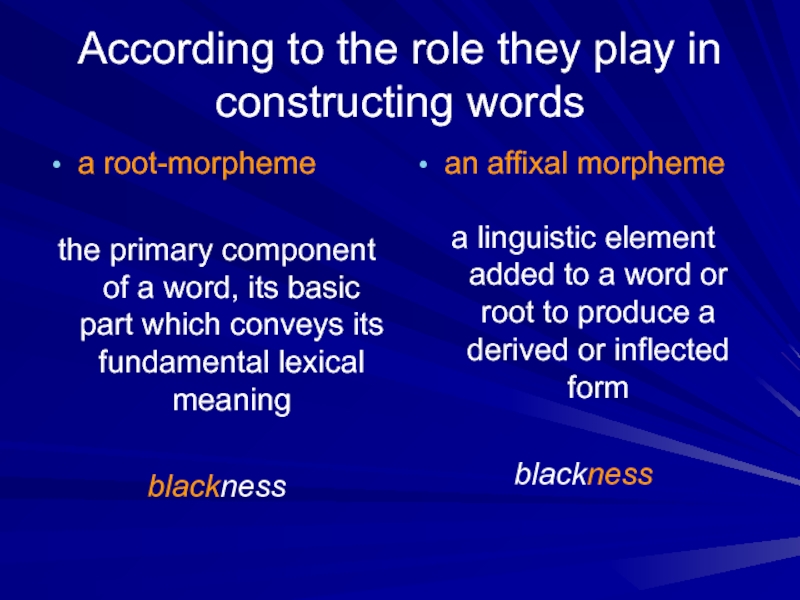
Слайд 13affixal or affixational morphemes
inflectional morphemes
(inflections)
possess grammatical meaning
dogs,
cups, trees
stands, sits, reads
derivational morphemes
(affixes)
possess lexical-grammatical
meaning
-ful
gram. meaning of an adjective-forming suffix
lexical meaning of «full of», «characterized by»
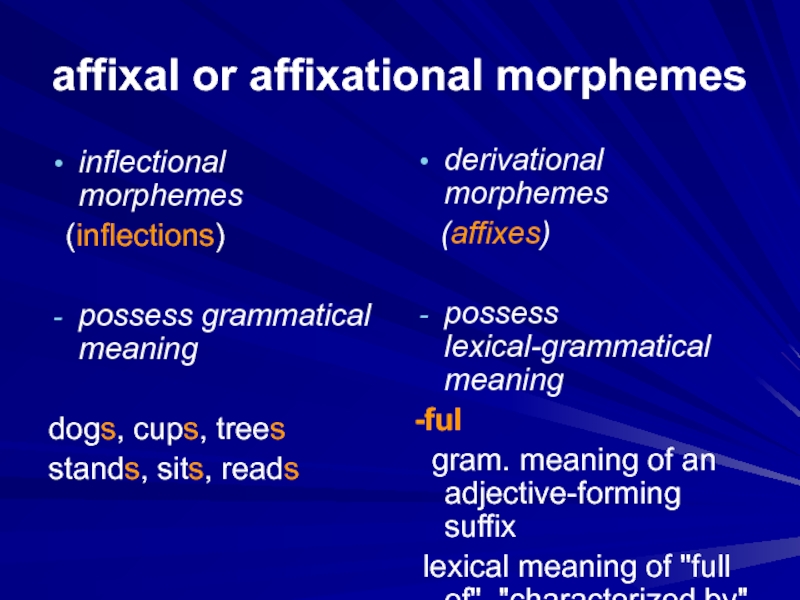
Слайд 14According to their position in words
prefixes
precede the root-morpheme
un-usual
re-read
mis-pronounce
un-well
suffixes
follow
the root-morpheme
home-less
teach-er
eat-able
dict-ate

Слайд 15According to the degree of freedom
free morphemes
friendship
bound morphemes
-er (worker), dis- (disadvantage)
semi-free(semi-bound morphemes)
fearless and less;
ship and friendship;
drinkable and able; hood and motherhood

Слайд 16an allomorph (from allo- ‘other, different’ + morpheme)
a positional variant
of a morpheme occurring in a specific environment
one or more
variants of a morpheme as conditioned by its position or by neighbouring sounds

Слайд 17the positional variants of lexico-grammatical morpheme «in-»
«il-» before l:
illegal, illiterate
«im-» before bilabials: immoral, impossible
«ir-» before r: irresponsible, irregular
The
morpheme «in-» has three allomorphs: im-; il-; ir-.
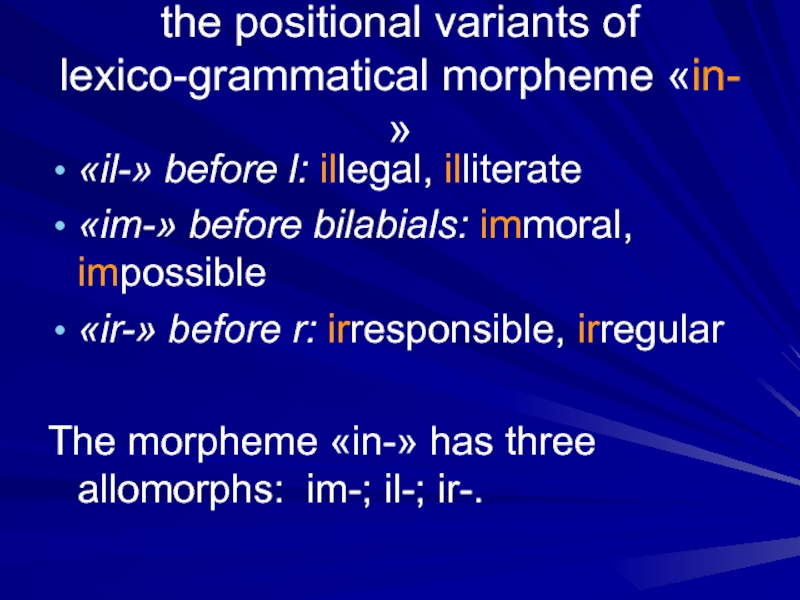
Слайд 18Morphemic segmentability of words
1. segmentable words
words in which segmentation into
morphemes is possible
agree-ment, fear-less
2. non-segmentable words
words which do not allow
any segmentation into morphemes
house, girl
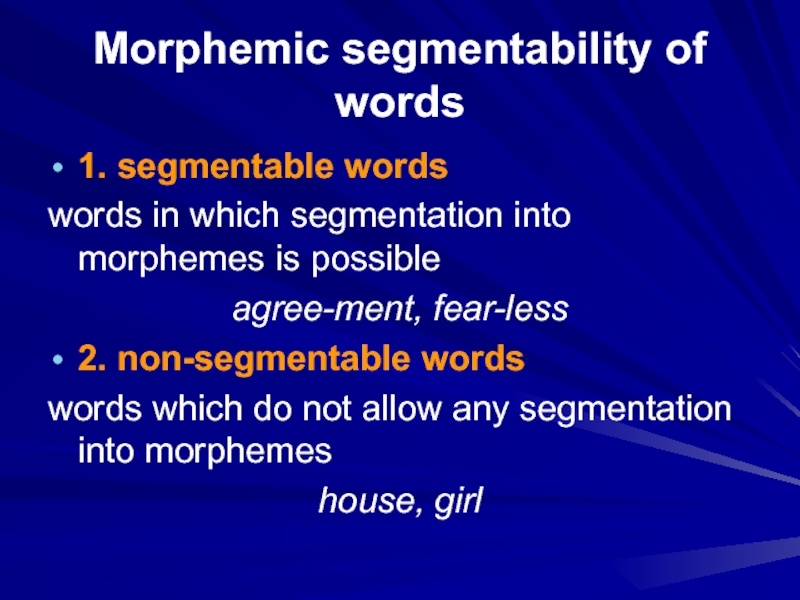
Слайд 19Types of morphemic segmentability of words
complete
«un» −not, lack
of, opposite
unemployment (n.), unable (adj.), untie (v.)
conditional
retain, contain,
detain the combinations re-, con-, de- don’t possess any lexical or functional meaning. Such morphemes are called
pseudo-morphemes or quasi-morphemes.
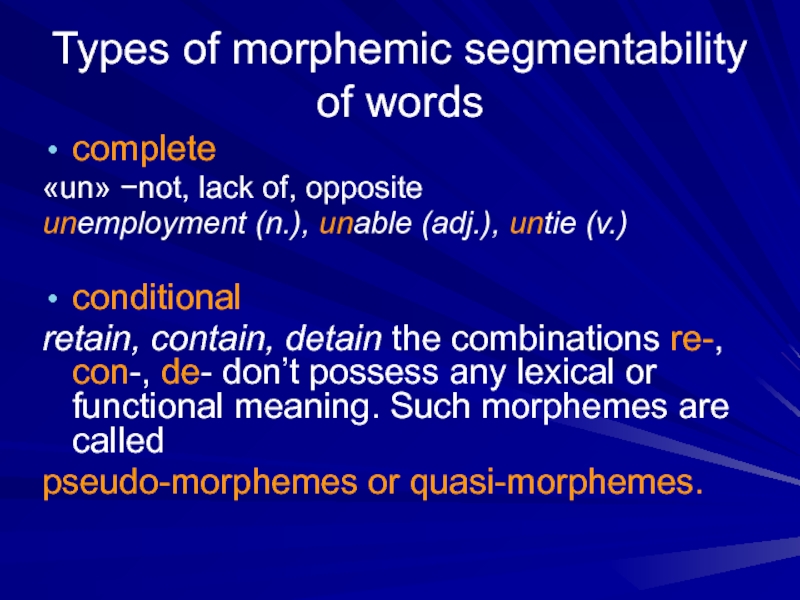
Слайд 20defective
takes place in words whose morphemes never
or seldom recur in other words. For example, in the
words «cranberry», «gooseberry», «strawberry», the morphemes «cran-», «goose-», «straw-» are unique morphemes.
неряха, ненавидеть
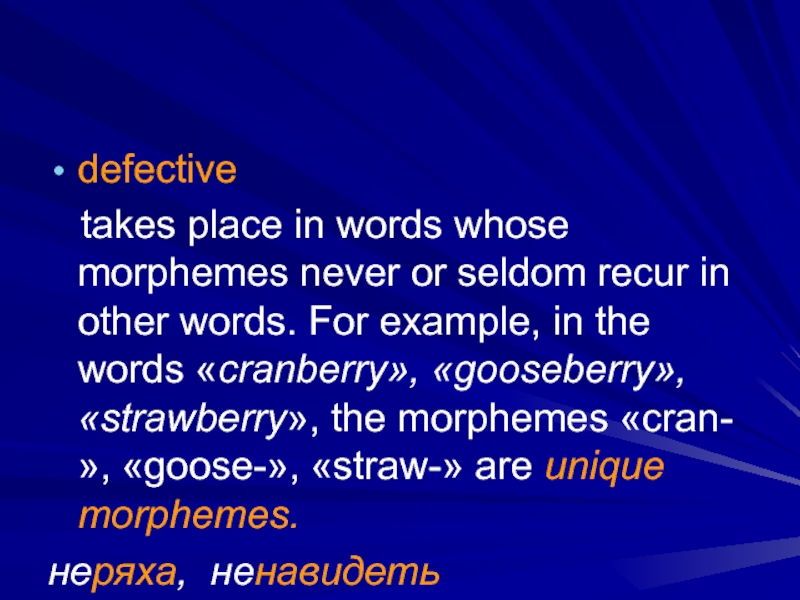
Слайд 21The Concept of a zero morpheme
1. «The sheep is in
the field».
2. «The sheep are in the field».
the
plural morpheme of the noun is realized as a zero morpheme (or: zero allomorph) — {o}.
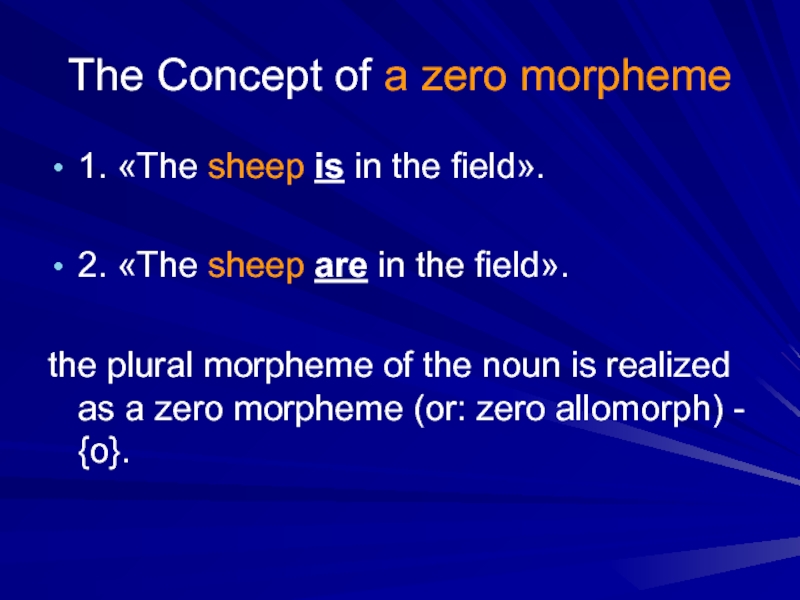
Слайд 221. I usually cut meat into small pieces.
2. Then she
cut the meat into small pieces.
In the verb «cut» of
the second sentence, the zero morpheme — {0} — is realized in the meaning of Past Simple Tense.
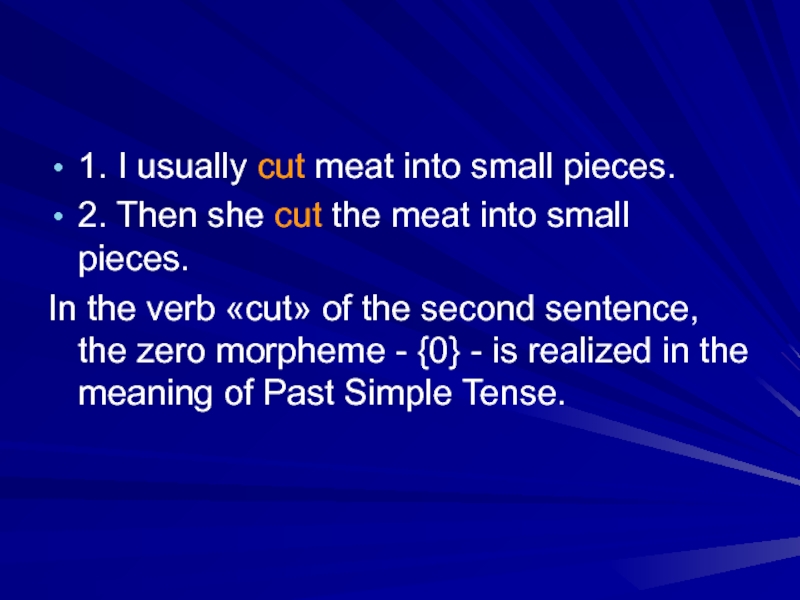
Слайд 23In Ukrainian in such words as дід, кут, рів there
are zero morphemes, which contain the grammatical meaning of nominative
case and masculine gender.
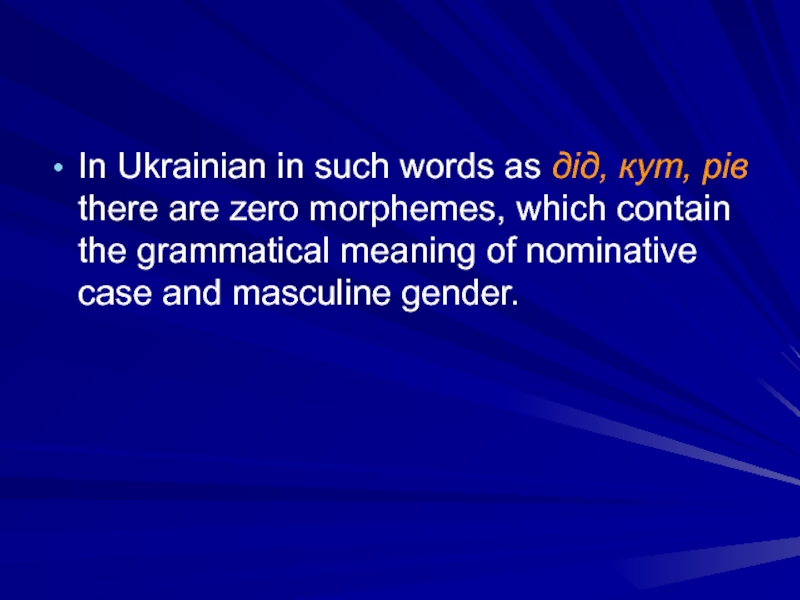
Related Papers
The term ‘degrammaticalization’, originally coined by Lehmann in 1982 for a supposedly non-existent phenomenon, soon came to be applied to a number of often entirely different changes. Since such ‘counterexamples’ pose a potential challenge to the unidirectionality of grammaticalization, they have been the focus of much attention from grammaticalizationists and grammaticalization critics alike. While the former have attempted to dismiss them as insignificant, the latter have tended to over-emphasize their relevance. Much of the debate on degrammaticalization is rooted in different understandings of what degrammaticalization entails, or what it should entail. This paper proposes a descriptive framework which will restrict the number of potential examples of degrammaticalization, while at the same time subdividing them into three clearly distinguishable subtypes.
Schmid, Hans-Jörg, «The scope of word-formation research». In: P.O. Müller, I. Ohnheiser, S. Olsen and F. Rainer, eds., Word-Formation. An International Handbook of the Languages of Europe. Vol. I. Berlin — Boston: De Gruyter Mouton, 1-21.
The scope of word-formation research
The first article of a handbook, this paper presents an introductory survey of the scope of word-formation research. It defines and demarcates the subject-matter of word-formation and explains the basic notions related to the internal structures of complex lexemes and the cross-linguistically important word-formation patterns. Major approaches, analytical and descriptive levels and models in the field of word-formation research are outlined from a bird’s eye view. The final section deals with productivity and lexicalization.
In: Heiko Narrog & Bernd Heine (eds) The Oxford Handbook of Grammaticalization, 475-487. Oxford : Oxford University Press
Degrammaticalization
This paper is concerned with changes on the level of morphology in grammaticalization and degrammaticalization. Using data from a wide variety of languages, grammaticalization is shown to have various effects, ranging from the loss of inflection in primary grammaticalization to the development of bound morphemes or new inflectional classes in secondary grammaticalization. By contrast, in degrammaticalization new inflections may be acquired and erstwhile bound morphemes may become free morphemes. The morphological changes attested in grammaticalization and degrammaticalization are further contrasted to related processes that involve morphological change, such as category shifts, lexicalization, and exaptation. To appear on: https://oxfordre.com/linguistics/
This paper is concerned with the analysis and citation of morphological phrasemes in the Athabaskan language Dene Sųłiné. The concepts of derivation, morphoids, submorphs and morphological phraseme are reviewed, and a few principles are suggested for distinguishing morphological phrasemes from transparent derivation, followed by corollaries of how these principles can be applied to the presentation of interlinearized examples. This approach is contrasted with the current practice in Athabaskan and Americanist linguistics of not distinguishing between derivation and morphological phrasemes in the morphemic glosses.
This study aims to analyze and describe the morphemic and phonemic structures of verbs and nouns in a research abstract as source of data. The morphemic structure analysis focuses on the free-bound morphemic affixations of English verbs and nouns while the morphophonemic analysis focuses on the allomorph variations of the inflectional morphemes in English verbs and nouns. Findings of the study reveal that majority of the verbs used in the research abstract have inflectional type of affixations where a bound morpheme is added to the stem as suffix. These morphemes mark tense and number of verbs. The nouns, on the other hand, generally have derivational affixation that involves appending of suffixes to the verb form to derive the noun form. This study affirms that English verbs and nouns generally have inflectional suffixes to mark grammatical categories such as tense and number. In another note, both of the verbs and nouns with inflectional morphemes undergo phonological modifications in terms of their allomorphic variants. The allomorphs [s], [z] and [iz] of the morpheme{s} are used to mark number in nouns and tense in verbs while the allomorphs [d], [ǝd] and [t] of the morpheme {d} mark the tense in regular verbs with inflectional morphemes. The allomorphs in both verbs and nouns involve voicing assimilation and dissimilation as phonological processes. The implications of the findings of the study would be that second language learners of English need to familiarize the morphemic structure of words as they can be very helpful in understanding the meanings of words. Moreover, they have to familiarize the environments where the allomorphic variants of inflectional morphemes are realized so that they would be able to pronounce the words correctly. Such interaction of morphology and phonology can cause learning difficulty for second language learners of English whose first language, like the Cebuano Visayan, is sounded as spelled and is contrary to English which has allophonic and allomorphic variants occurring in words. The analysis can, therefore, be helpful to teachers in identifying areas of difficulty in learning a second language.
